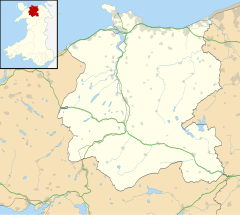Llanddulas and Rhyd-y-foel
Llanddulas and Rhyd-y-foel
|
|
|---|---|
 Honeycomb worm reef at Llanddulas |
|
| Llanddulas and Rhyd-y-foel shown within Conwy | |
| Population | 1,542 (2011) |
| OS grid reference | SH9078 |
| Community |
|
| Principal area | |
| Ceremonial county | |
| Country | Wales |
| Sovereign state | United Kingdom |
| Post town | ABERGELE |
| Postcode district | LL22 |
| Dialling code | 01492 |
| Police | North Wales |
| Fire | North Wales |
| Ambulance | Welsh |
| EU Parliament | Wales |
| UK Parliament | |
| Welsh Assembly | |
Llanddulas and Rhyd-y-foel (Welsh: Llanddulas a Rhyd-y-foel) is a community in Conwy County Borough, in Wales. It is located on the coast of Liverpool Bay, at the mouth of the Afon Dulas, 2.7 miles (4.3 km) west of Abergele, 3.6 miles (5.8 km) east of Colwyn Bay and 9.0 miles (14.5 km) east of Conwy. As the name suggests, it consists of the villages of Llanddulas and Rhyd-y-foel. At the 2001 census the community had a population of 1,572, reducing slightly to 1,542 at the 2011 census.
Now derelict, Gwrych Castle stands on the hillside to the east of Llanddulas. Built between 1812 and 1822 by Lloyd Hesketh Bamford-Hesketh, it has been described as a "spectacular and romantic flight of gothic fancy," and was an attempt to create a replica of an Edwardian fortress. The castle contains 18 towers, and is surrounded by terraced gardens and woodland, with gothic park walling, lodges and towers. The total frontage is over 0.8 miles (1.3 km) in length, and has been described as "one of the finest examples of its date in Britain" by Cadw. It is Grade I listed. In November 2011, planning permission was granted to convert the building into a hotel, conference centre and spa.
Saint Cynbryd's Church, in Llanddulas, dates from 1868, and was designed by George Edmund Street, who was also responsible for the Royal Courts of Justice in London. It is on the site of an earlier medieval church which had been rebuilt in 1732, and was commissioned by Robert Bamford-Hesketh of Gwrych Castle. It is described by Cadw as being "of subtle sophistication and quiet mastery" and is Grade II* listed. Similarly listed is Plas Tan-yr-ogof, a farmhouse on the Gwrych estate, built in 1819, which was used for a while as a night club.
...
Wikipedia

